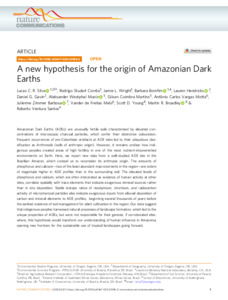Silva, Lucas CR;
Corrêa, Rodrigo Studart;
Wright, Jamie L;
Bomfim, Barbara;
Hendricks, Lauren;
Gavin, Daniel G;
Muniz, Aleksander Westphal;
... Santos, Roberto Ventura; + view all
(2021)
A new hypothesis for the origin of Amazonian Dark Earths.
Nature Communications
, 12
(1)
, Article 127. 10.1038/s41467-020-20184-2.

![[thumbnail of Arroyo-Kalin_A new hypothesis for the origin of Amazonian Dark Earths_VoR.pdf]](https://discovery.ucl.ac.uk/10151835/3.hassmallThumbnailVersion/Arroyo-Kalin_A%20new%20hypothesis%20for%20the%20origin%20of%20Amazonian%20Dark%20Earths_VoR.pdf)  Preview |
Text
Arroyo-Kalin_A new hypothesis for the origin of Amazonian Dark Earths_VoR.pdf Download (8MB) | Preview |
Abstract
Amazonian Dark Earths (ADEs) are unusually fertile soils characterised by elevated concentrations of microscopic charcoal particles, which confer their distinctive colouration. Frequent occurrences of pre-Columbian artefacts at ADE sites led to their ubiquitous classification as Anthrosols (soils of anthropic origin). However, it remains unclear how indigenous peoples created areas of high fertility in one of the most nutrient-impoverished environments on Earth. Here, we report new data from a well-studied ADE site in the Brazilian Amazon, which compel us to reconsider its anthropic origin. The amounts of phosphorus and calcium—two of the least abundant macronutrients in the region—are orders of magnitude higher in ADE profiles than in the surrounding soil. The elevated levels of phosphorus and calcium, which are often interpreted as evidence of human activity at other sites, correlate spatially with trace elements that indicate exogenous mineral sources rather than in situ deposition. Stable isotope ratios of neodymium, strontium, and radiocarbon activity of microcharcoal particles also indicate exogenous inputs from alluvial deposition of carbon and mineral elements to ADE profiles, beginning several thousands of years before the earliest evidence of soil management for plant cultivation in the region. Our data suggest that indigenous peoples harnessed natural processes of landscape formation, which led to the unique properties of ADEs, but were not responsible for their genesis. If corroborated elsewhere, this hypothesis would transform our understanding of human influence in Amazonia, opening new frontiers for the sustainable use of tropical landscapes going forward.
| Type: | Article |
|---|---|
| Title: | A new hypothesis for the origin of Amazonian Dark Earths |
| Open access status: | An open access version is available from UCL Discovery |
| DOI: | 10.1038/s41467-020-20184-2 |
| Publisher version: | https://doi.org/10.1038/s41467-020-20184-2 |
| Language: | English |
| Additional information: | © 2022 Springer Nature Limited. This article is licensed under a Creative Commons Attribution 4.0 International License (http://creativecommons.org/licenses/by/4.0/). |
| UCL classification: | UCL > Provost and Vice Provost Offices > UCL SLASH > Faculty of S&HS UCL > Provost and Vice Provost Offices > UCL SLASH > Faculty of S&HS > Institute of Archaeology > Institute of Archaeology Gordon Square UCL > Provost and Vice Provost Offices > UCL SLASH UCL UCL > Provost and Vice Provost Offices > UCL SLASH > Faculty of S&HS > Institute of Archaeology |
| URI: | https://discovery.ucl.ac.uk/id/eprint/10151835 |
Archive Staff Only
 |
View Item |


